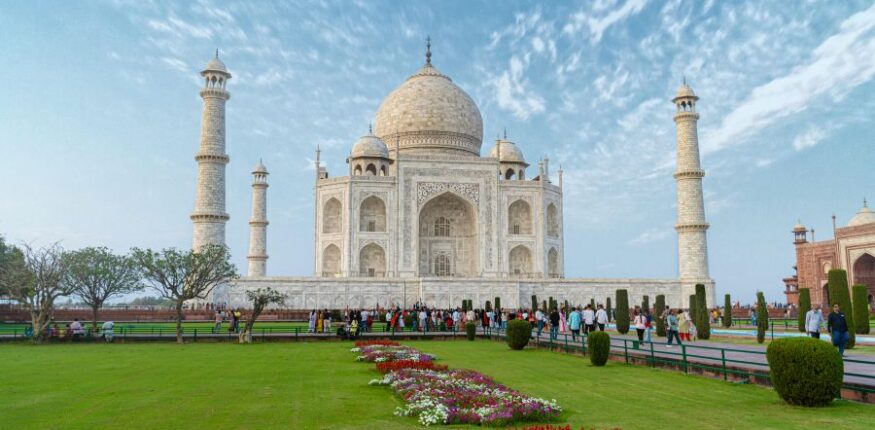Why Visit the Taj Mahal?
The Taj Mahal is more than just a monument—it’s a symbol of love, artistry, and architectural brilliance. Built in the 17th century by Emperor Shah Jahan in memory of his beloved wife Mumtaz Mahal, this ivory-white mausoleum is one of the most visited wonders of the world. Whether you’re an architecture enthusiast, a history buff, or a traveler seeking breathtaking beauty, the Taj Mahal is an unmissable destination.

The Taj Mahal is a UNESCO World Heritage Site and one of the most photographed landmarks in the world. People from all over the globe visit this magnificent structure to witness its stunning design, which is a blend of Persian, Turkish, and Indian architectural elements. The moment you set your eyes on it, you will understand why it is considered one of the greatest expressions of love ever built.
A Journey Through History
Stepping into the Taj Mahal complex is like traveling back in time. The intricate carvings, Persian-inspired gardens, and the stunning reflection of the structure in the adjacent Yamuna River create an ethereal experience. As the morning sun bathes the white marble in golden hues and the evening moonlight gives it an almost surreal glow, the Taj Mahal transforms into an unforgettable spectacle.
The Story Behind the Taj Mahal
The Taj Mahal’s construction began in 1632 and took approximately 22 years to complete, involving more than 20,000 artisans and craftsmen. Emperor Shah Jahan commissioned this grand mausoleum to honor his beloved wife Mumtaz Mahal, who passed away while giving birth to their 14th child. The love story behind this monument makes it even more significant, as it symbolizes eternal devotion.
Interestingly, legend has it that Shah Jahan planned to build a black marble replica of the Taj Mahal on the opposite side of the Yamuna River as his own tomb. However, his plans were halted when he was overthrown by his son, Aurangzeb, and imprisoned in Agra Fort. From his confinement, he spent his final years gazing upon the Taj Mahal, longing to be reunited with his beloved wife.

The Art and Architecture
The Taj Mahal is a masterpiece of Mughal architecture, combining Persian, Indian, and Islamic influences. The white marble structure is inlaid with semi-precious stones, forming intricate floral patterns that add to its grandeur. The perfectly symmetrical layout, the towering minarets, and the detailed calligraphy from the Quran adorning the walls make it a true marvel of craftsmanship.
The Gardens
One of the most stunning aspects of the Taj Mahal is its lush, well-manicured gardens. Known as the Charbagh, the garden follows the Persian-style layout, divided into four sections by water channels. The reflection of the Taj Mahal in these water channels creates a picture-perfect view, making it one of the most iconic images captured by travelers.
The Interiors
While the exterior of the Taj Mahal is breathtaking, its interiors are equally mesmerizing. The central chamber houses the tombs of Shah Jahan and Mumtaz Mahal, but the real graves lie in a lower, sealed chamber beneath. The inlay work inside the mausoleum, made of precious and semi-precious stones such as jade, turquoise, and lapis lazuli, reflects the exquisite craftsmanship of the Mughal era.
The Taj Mahal Experience
Visiting the Taj Mahal is more than just sightseeing; it’s an emotional and spiritual experience. Whether you visit during sunrise, sunset, or under the moonlight, the monument never fails to leave an everlasting impression.
Best Times to Visit the Taj Mahal
- Sunrise Visit: Witness the beauty of the Taj Mahal as the first light of day touches its marble surface, creating a magical golden glow. This is the best time for photography, as there are fewer crowds and the cool morning air enhances the experience.
- Sunset View: Enjoy the tranquil atmosphere as the setting sun casts a dreamy pinkish hue on the monument. The reflections in the surrounding water add to the charm.
- Moonlight Visit: On select nights, experience the Taj Mahal under the soft glow of the full moon, offering a breathtaking and romantic ambiance. These tickets are limited, so it is advisable to book in advance.
- Off-Peak Hours: If you prefer a less crowded experience, visiting during the late afternoon or early morning on weekdays is ideal.
Nearby Attractions in Agra
While the Taj Mahal is the highlight of Agra, there are many other historical and cultural attractions worth exploring:
- Agra Fort: A UNESCO World Heritage Site, this red sandstone fort was once the main residence of the Mughal emperors. It offers stunning views of the Taj Mahal from its terraces.
- Fatehpur Sikri: An abandoned Mughal city located about 40 km from Agra, featuring stunning palaces, mosques, and courtyards.
- Mehtab Bagh: A garden complex situated across the Yamuna River, offering the perfect vantage point to view and photograph the Taj Mahal.
- Tomb of Itimad-ud-Daulah: Often referred to as the “Baby Taj,” this exquisite tomb predates the Taj Mahal and is a fine example of Mughal architecture.

Why Book Your Taj Mahal Tour with us?
We specialize in curating personalized and seamless travel experiences. Our expert guides provide insightful historical narratives, ensuring that your visit to the Taj Mahal is not just a tour but a deeply enriching journey. With comfortable transportation, hassle-free arrangements, and exclusive experiences, we ensure a memorable and stress-free adventure in India.
What We Offer:
- Expert Guided Tours: Our knowledgeable guides will take you through the history, myths, and architectural wonders of the Taj Mahal and Agra’s other iconic landmarks.
- Hassle-Free Transportation: Enjoy a comfortable journey from Delhi to Agra in our luxury vehicles.
- Customizable Packages: Whether you prefer a one-day Agra tour or an extended Golden Triangle tour, we tailor our itineraries to suit your needs.
- Photography Assistance: Capture the best moments with the help of our experienced photographers who know the best angles and spots.
The Forgotten Pain: The Artisans Behind the Taj Mahal
The Taj Mahal stands as a testament to love and architectural brilliance, but behind its beauty lies a chilling legend. It is said that after the monument was completed, Emperor Shah Jahan ordered the hands of hundreds of artisans to be severed, ensuring that no other masterpiece could rival its perfection.
These skilled craftsmen, who dedicated years of their lives to carving intricate floral patterns, embedding semi-precious stones, and perfecting the calligraphy on the marble walls, paid a devastating price for their artistry. Whether myth or reality, the tale of these laborers serves as a stark reminder of the sacrifices made to create one of the world’s most magnificent wonders.
Frequently Asked Questions (FAQs)
1. What is the best time to visit the Taj Mahal?
The best time to visit the Taj Mahal is from October to March when the weather is pleasant. Early mornings and late afternoons provide the best lighting for photography, while full moon nights offer a unique, ethereal experience.
2. How much is the entry fee for the Taj Mahal?
The entry fee varies based on nationality:
- Foreign tourists: INR 1,300
- SAARC/BIMSTEC nationals: INR 740
- Indian citizens: INR 50
There is an additional charge of INR 200 for visiting the main mausoleum.
3. Is there a dress code for visiting the Taj Mahal?
There is no strict dress code, but modest clothing is recommended as it is a historical and cultural site. Comfortable footwear is advisable due to walking distances.
4. Can I bring my camera inside the Taj Mahal?
Yes, cameras are allowed, but tripods and professional equipment require special permission. Photography inside the main mausoleum is prohibited.
5. Are there any restrictions on visiting the Taj Mahal?
Yes, visitors are not allowed to bring large bags, food, or tobacco products inside the monument. Security checks are in place at the entrance.
6. How can I book a full moon visit to the Taj Mahal?
Full moon visit tickets must be booked in advance through the Archaeological Survey of India (ASI) website or at the local office in Agra. Only 400 visitors are allowed per night, divided into batches.
7. What is the best way to travel from Delhi to the Taj Mahal?
The best options are:
- By Train: Gatimaan Express (fastest) or Shatabdi Express
- By Road: A comfortable 3-4 hour drive via the Yamuna Expressway
- By Air: The nearest airport is in Agra, but flights are limited.
8. Is the Taj Mahal open every day?
The Taj Mahal is open daily except on Fridays, when it is closed for prayers.
9. How long does a visit to the Taj Mahal take?
A typical visit lasts around 2-3 hours, but if you plan to explore nearby attractions, a full-day trip is ideal.
10. What other attractions can I visit in Agra?
Along with the Taj Mahal, you can visit Agra Fort, Fatehpur Sikri, Mehtab Bagh, and the Tomb of Itimad-ud-Daulah for a complete Mughal heritage experience.
Conclusion: Experience the Magic of the Taj Mahal with Go High Travels
A visit to the Taj Mahal is not just a journey to one of the world’s most breathtaking monuments; it is an experience filled with history, art, and emotion. Standing before this symbol of eternal love, you will feel the passion and devotion that went into its creation. Whether you’re admiring its intricate craftsmanship, strolling through the lush Charbagh gardens, or capturing its stunning reflections in the Yamuna River, the Taj Mahal promises memories that will stay with you forever.
At Go High Travels, we are dedicated to making your Taj Mahal visit truly unforgettable. With our expertly curated tours, personalized service, and in-depth historical insights, we ensure that your trip is seamless and enriching. Whether you’re a history lover, a romantic at heart, or simply in awe of architectural brilliance, our tours cater to all interests and preferences.
Book your dream journey today! Let Go High Travels handle all the details while you soak in the beauty of one of the world’s greatest wonders. Contact us now to plan your visit!
📲 WhatsApp: +91-9717027483
📞 Call Us: +91-97170-27483
📧 Email: info@gohightravels.com




